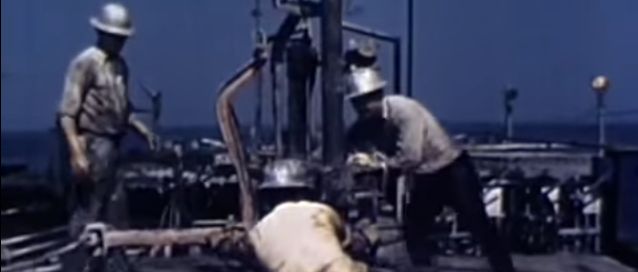Drilling into Earth’s mantle, a holy grail of geology, set to begin once again

An old challenge – geology's holy grail of drilling into the Earth's mantle – is set to begin once again, as a group of experts heads out for the Atlantis Bank, Indian Ocean to drill through 1.5 kilometers (0.93 miles) of rock, collecting core samples on its way. The first phase of the expedition will commence in the early December 2015 and last until the end of January 2016. If the start is successful the team will come back again to try and drill all the way down to the MOHO layer.
One of the most well known quests of geology began almost 60 years ago, at the peak of the plate tectonics revolution. Many experts have tried to achieve this since and were unsuccessful to date. The challenge is once again being met by a drilling expedition onboard JOIDES Resolution set to depart Colombo, Sri Lanka and sail to the Atlantis Bank spot in the southwestern Indian Ocean in the early December 2015.
The crust-mantle boundary named Mohorovicic discontinuity, or MOHO, at which seismic waves change their travel velocity is located about 7 km (4.5 miles) beneath the oceanic crust and between 30 and 60 km (18.6 and 37.3 miles) down beneath continents. At Atlantis Bank, the mantle is settled 2.5 km above the MOHO, making it easier to reach.
According to Henry Dick, a geophysicist at the Woods Hole Oceanographic Institution (WHOI) and expedition's co-leader, achieving this goal presents "one of the greatest scientific endeavours of the century". The drilling project, named "Slow Spreading Ridge Moho" (SloMo), experts will utilize the Japanese vehicle to reach the crust-mantle transition at Atlantis Bank. The expedition will hopefully also provide good quality data to answer some questions about other properties of our planet, for example how molten rock rises from the interior and cools while forming fresh oceanic crust.
A drilled hole would be the window into things we have never seen before, according to Benoit Ildefonse, a geologist at the University of Montpellier in France.
During the 1960s, scientists involved into the "Project Mohole", tried to drill into the sea floor off Guadalupe Island, Mexico. The project reached depths of only 183 meters (600.4 feet) before it was shut down due to too high expenses. The project yielded many scientific ocean-drilling programmes responsible for collecting core samples from hundreds locations across the globe and retrieving millions of years of sedimentary records.
"We live on this Earth and we ought to know something about what happens beneath us,"said Walter Munk, an oceanographer at the Scripps Institution of Oceanography in La Jolla, California, who conceived Project Mohole with colleagues over cocktails one evening in 1957.
In the period between 2002 and 2011, four holes at a site in the eastern Pacific managed to reach fine-grained, brittle rock, most likely a cooled magma sitting just above the Moho. But the drill was unable to pierce further. Similarly, drillers at the nearby Hess Deep were limited by tough deep-crustal rocks in the 2013 expedition.
The 2015 team of experts will conduct the drilling in the Indian Ocean Ridge instead, as much smaller lava quantities seem to feed the seafloor there.
A preliminary goal is set to penetrate to the depths of 1.5 km, and it has been done before. During this first phase, the scientists are hoping to explore the geology and biology of the area. Available geological maps suggest the seawater has percolated several kilometers deep at Atlantis Bank and triggered chemical reactions responsible for turning the rock into a type known as serpentite. According to Virginia Edgcomb, a microbiologists at WHOI, the team will also survey the rocks searching for microorganisms.
If SloMo's first phase is successfully completed, experts will return to the area with the JOIDES Resolution to try to reach depths up to 3 km (1.9 miles). After that, Dick and his colleagues will sail out on the Japanese state of the art ship Chikyu to try to drill all the way down to MOHO layer.
See also:

Video credit: Periscope Film
Featured image: Earth drilling during Mohole project in 1960s. Image credit: Periscope Film

This looks like a thinly disguised weapons research program. Woods Hole is part of Navy intel and uses phony eco-studies and ‘nature’ research to do weapons dev. for submarine warfare, spying and tectonic warfare.
What a junk project
It is socialism for the rich and capitlism for the rest of us.
Capitalists want taxpayers money and they always invent projects that have no values and mostly based on speculation. The drilling cannot exceed 15 km at the most. The Russian or rather the (Soviet) could not drill further than 12,54 Km. This project will only make the capitalists fatter. The money can be better spent on valuable and real science projects.